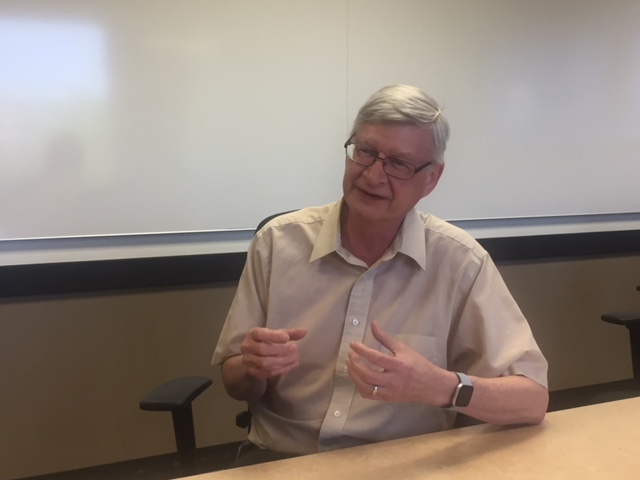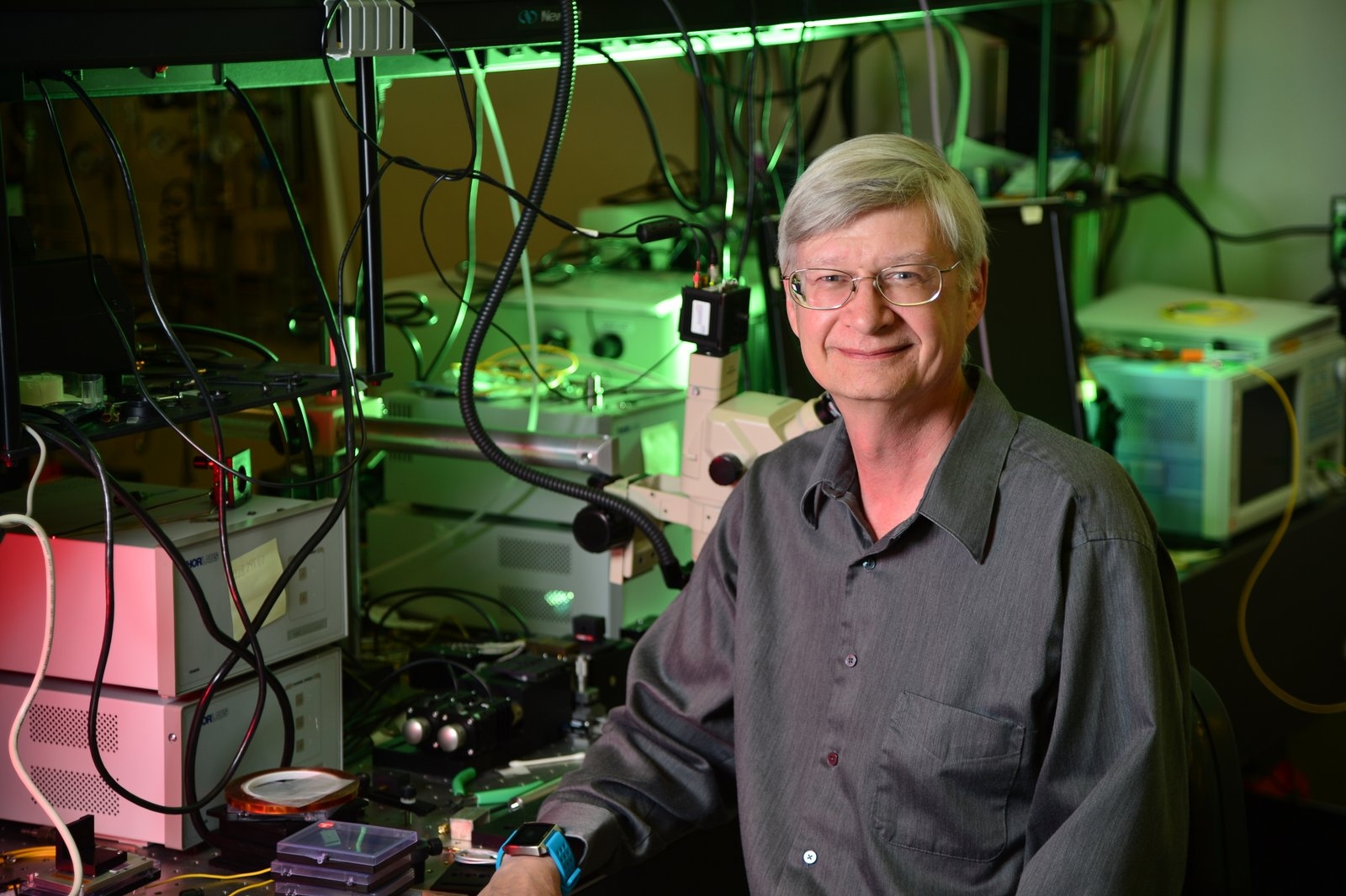The chief technology officer of Intel on the future of tech and how Oregon drives innovation.
Michael Mayberry, chief technology officer at Intel, oversees the company’s most cutting-edge research and development. A 35-year veteran of the firm, Mayberryhas held a number of key technical roles, including developing test processes for Intel microprocessors, as well as leading Intel’s product-driven research. In this interview, edited for length and clarity, Mayberry reflects on Oregon’s future as a tech leader and what’s the next new thing in microchip manufacturing.
On how Intel stays innovative
There was a period in our history where our basic process was just to make it smaller, and then fix it because you broke something along the way. We’re well past that. Now we’re bringing new materials in to do novel things, whether it be a camera sensor or different kind of memory. We’re also building things up in layers. We’re packing more information into each individual memory sum. We’ll continue to do that moving forward.
On Intel’s future in Oregon
There are fewer of us at the leading edge, so those of us on the leading edge have to invest more. We’ll continue to invest in technology here. [Intel’s Oregon campus] is where we will begin a new advance node, and then fan out production elsewhere.
On standardization
In the 90’s, everybody could code for one platform. Now there’s different coding for your cell phone, computer and the things on your wall. Less standardization raises challenges and opportunities for software companies. Using one kind of coding across platforms slows things down, which creates opportunities for anyone who can speed things up. People at Intel are working on those challenges.
On the rise of big data
We live in a time when data is being generated, analyzed and consumed in multiple different places. You have data coming from phones, you have traffic systems which create data, you have automated driving that creates new data. All that data need to go somewhere to have things done computationally. It doesn’t all go to the same place. That challenge employs a lot of creativity in the industry.
On the valuation of data
Data is valuable. Turning that data into information is even more valuable. I have said that information is more valuable than cost, and time is more valuable than information. You want to spend money to get information, and you want it as fast as you can. I think there will be a law someone will articulate on the value of data. I haven’t heard what precisely it is yet, but something about how data gets more valuable over time.
On sustainability in the tech sector
There’s a green element in being able to create more efficient technology. We spend a lot of time looking at the inputs and outputs, and improving [silicon wafers] are a part of that problem. We use green chemistry wherever we can, aim to minimize quantity, then look at disposal.
 Credit: Laurie Smith Dejong
Credit: Laurie Smith Dejong
On the environmental impact of mining for rare earth metals
I’ve been asked many times about rare earth metals, and I don’t think people realize how little of those elements we actually use. Sometimes only a few atoms. The amount of minerals is so miniscule when compared to, say, a refrigerator magnet.
On how consumers influence the tech sector
I would drive the industry very differently if consumers would all say, “All I care about is more battery life,” or “I want to be able to go back on forth between devices, and not have one device to rule them all.” That’s why feedback is important. There is goodness from the technology. How we spend that “goodness” is ultimately what people buy. If we knew what people were going to buy then we’d all be a lot richer.
On his priorities as chief technology officer
The CTO position is a combination of things; first, it’s getting the company to work on the right things to prepare for the future. It’s to make sure our co-travelers outside the company know what we are working on so they can work better. There’s also a little bit of “prepping the market.” You can’t buy these things right now, but they will be available in five, ten years’ time.
On the realities of quantum computing
I can’t sell you a quantum computer today. If I did you wouldn’t be able to use it. But we can talk about it as a technology and what it can do for the world, and prepare for the day where it is more commonplace. Not as commonplace as a cell phone, certainly, but certainly able to be used.
On quantum computing’s timeline
We say its about ten years’ away. There are some in the industry who say quantum computing is already here. From our perspective, the point at which quantum computers are able to do things that are interesting, is about ten years’ away.
On talent in the tech industry
Talent is one piece of the equation, but attitude is the other part. You need to understand the reality that no matter what skills you might bring to the company today, very soon you’re going to have to learn something different. Finding people with the ability to branch beyond what they know now is one of the key things we look for.
On the rise of cross-disciplinary projects.
I think some of the most exciting things we are working on are on the boundary of a discipline and something else. Early on in my career I was a chemist, so I had to learn how transistors work so I could marry them together. Now we have our neuromorphic computer chip. We want it to mimic the design of how the brain works and communicates, which means working with people from the neuroscience field.
On the advice would he give to the next CTO of Intel
I would tell them the same thing that was told to me, which is “Don’t let Moore’s Law end on your watch.” Moore’s law ends when you run out of ideas, so don’t run out of ideas. I think the future is bright. I think the best times are ahead of us, not behind us, and the job of my successor is to make that a true statement.
[Moore’s Law refers to a 1965 observation, which found the amount of transistors in a closed circuit doubling every two years. It has since been reinterpreted to refer to the exponential growth of technology components]
RELATED STORY: Moore Money, Moore Problems?
On the future of Intel as a leader in the industry
There has to be a little of “don’t be complacent.” At times in our history we’ve become complacent and have had to get back into the game. You have to stay optimistic. It’s always the consumer who gives you the problem to solve, not what you find most interesting as an engineer.
On the future of the tech industry
If you go back in time, what you see is that there has been a lot of consolidation between fewer and fewer suppliers. There are roughly seven companies on the cutting-edge today, about half of them working on memory and half working on logic. Those of us at the leading edge need to decide whether to go more general purpose or become more specialized. It’s a challenge we all are facing together.
On Oregon’s future as a tech leader
Oregon is a great place for technology because of network effects. When we first moved to Oregon in 1974 there was nothing here, then a few other companies came here and we started calling it the Silicone Forest. That all happened because there was more than one of us, and we could help each other with different things. Software companies helping hardware companies and so forth. I think that’s part of the reason this region has thrived – that basic network effect.
On legislation to drive innovation forward
We care a lot about being able to bring the best and the brightest, no matter where in the world they were born. My teams have a great deal of people who were born somewhere else but educated in the U.S. Having people who were educated in the U.S. be able to work in the U.S. is something that I personally am very passionate about.
To subscribe to Oregon Business, click here.







